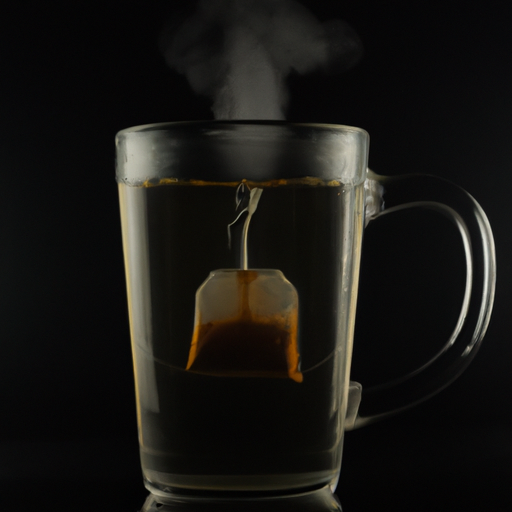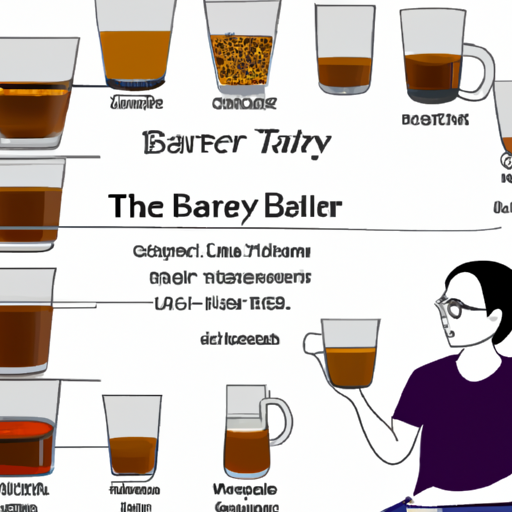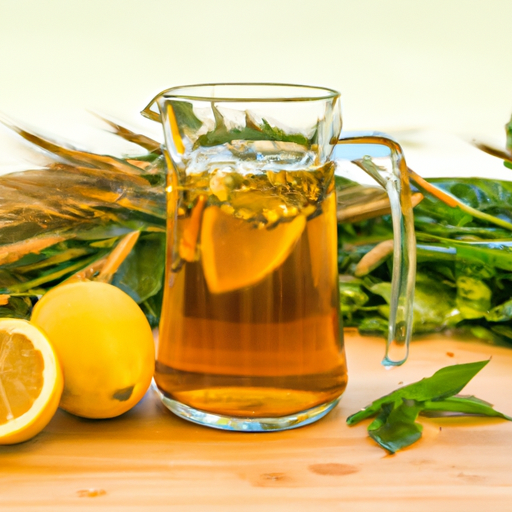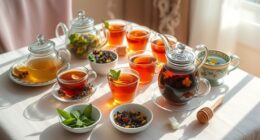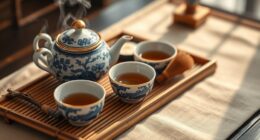Have you ever pondered about the delightful, invigorating beverage you savored at your preferred Korean eatery? That, my dear friends, happens to be barley tea.
A euphemistically named beverage, barley tea is a popular drink in East Asia, particularly in Korea, Japan, and China. Barley tea is a caffeine-free infusion made from roasted barley grains. The tea is brewed by steeping the grains in boiling water.
The resulting beverage has a nutty, toasted flavor and a slight sweetness. It is usually served hot or cold and is a staple in many East Asian households. But barley tea is more than just a drink – it has a rich cultural history, boasts numerous health benefits, and is a popular summer beverage.
So let’s dive in and explore what exactly barley tea is and why you should give it a try.
Key Takeaways
- Barley tea is a popular East Asian drink made from roasted barley grains, with a nutty, toasted flavor, and is served hot or cold.
- Drinking barley tea regularly has numerous health benefits, including being a rich source of antioxidants, anti-inflammatory properties, and regulating blood sugar levels.
- Barley tea is a low-calorie alternative to sugary drinks, and its consumption can help with weight loss, gut health, and relieving bloating and constipation.
- Barley tea is a staple in many East Asian households, has cultural significance, and is a versatile ingredient that can be used in cooking.
History and Origins of Barley Tea
Let’s dive into the fascinating history and origins of barley tea, a beloved and refreshing beverage enjoyed for centuries. Barley tea, also known as mugicha, is a caffeine-free and non-alcoholic beverage made from roasted barley grains. This tea has been a staple in East Asian cultures for over a thousand years, with its cultural significance and popularity dating back to the Joseon Dynasty in Korea.
Barley tea’s cultural significance is evident in its widespread consumption across different regions. In Korea, barley tea is often served as a welcome drink to guests and is a popular summertime beverage due to its cooling properties. In Japan, mugicha is consumed all year round, with many households brewing their own tea using roasted barley grains. It is also commonly found in vending machines and convenience stores throughout the country.
In China, barley tea is known as damai cha and is believed to have medicinal properties. It is often used to treat digestive issues and is believed to have a cooling effect on the body. Barley tea has also gained popularity in the Western world in recent years, with many health enthusiasts touting its numerous health benefits.
Now, let’s move on to how barley tea is made without further ado.
How Barley Tea is Made
I love making my own barley tea at home, and there are three key steps to the process.
First, I roast the barley grains to bring out their nutty flavor and aroma.
Then, I steep the grains in hot water for about 10-15 minutes, depending on how strong I want the tea to be.
Finally, I can add sweeteners like honey or flavorings like lemon to enhance the taste.
Making barley tea from scratch is easy and rewarding, and it’s a great way to enjoy a refreshing and healthy beverage.
Roasting Barley Grains
To achieve the perfect nutty flavor, roasting the barley grains is a crucial step in the process of making barley tea. This process involves heating the grains in a dry skillet or oven to bring out their natural flavors and aromas. The roasting process also helps to remove excess moisture from the grains, which can lead to spoilage.
During the roasting process, the barley grains will undergo several changes. At first, the grains will start to release a sweet, nutty aroma as their natural oils begin to heat up. As the grains continue to roast, their color will change from a pale yellow to a rich golden brown. To better illustrate this process, here’s a table that outlines the different stages of roasting and their corresponding flavor profiles:
| Roasting Stage | Grain Color | Flavor Profile |
|---|---|---|
| Light Roast | Pale yellow | Mild, slightly sweet |
| Medium Roast | Light brown | Nutty, slightly bitter |
| Dark Roast | Golden brown | Rich, bold, nutty |
After the barley grains have been roasted to perfection, the next step is to steep them in hot water.
Steeping Barley Grains in Hot Water
Once the roasted grains have reached the desired color and flavor, I immerse them in hot water to release their essence. The brewing process is relatively simple, but the results are magnificent.
I prefer to use filtered water and a stainless steel pot to brew my barley tea. I bring the water to a boil, then add the roasted grains and let them steep for about 10-15 minutes. I find this sufficient to release all the flavors and nutrients from the grains.
Barley tea benefits include being a rich source of antioxidants and having anti-inflammatory properties. It’s also believed to aid digestion and promote a healthy heart.
There are various brewing methods, including steeping in cold water overnight or using a tea infuser. Some people enjoy adding sweeteners or flavorings such as honey or lemon. However, I prefer mine plain as I find the roasted barley flavor to be the star of the show.
Adding Sweeteners or Flavorings
Adding sweeteners or flavorings to your brewed barley infusion can enhance its taste and provide additional health benefits. One of the most common ways to sweeten barley tea is by adding honey. Honey is a natural sweetener that not only adds flavor but also provides numerous health benefits. It’s rich in antioxidants, has antibacterial properties, and can soothe a sore throat.
Adding a teaspoon of honey to your barley tea is an excellent way to boost your immune system and fight off infections. Another way to enhance the flavor of barley tea is by adding lemon. Lemon not only adds a tangy flavor but also provides additional benefits to the drink. It’s rich in vitamin C, which can help improve your skin, boost your immune system, and aid in digestion.
Drinking barley tea with lemon can also help detoxify your body and improve your overall health. Whether you prefer honey or lemon, adding a sweetener or flavoring to your barley tea can make it a delicious and healthy beverage to enjoy.
Drinking barley tea with honey or lemon not only enhances the taste but also provides numerous health benefits. However, it’s essential to note that adding too much honey or sugar can negate some of the health benefits of the tea.
In the following section, we’ll discuss the nutritional value of barley tea and how it can benefit your health.
Nutritional Value of Barley Tea
When it comes to the nutritional value of barley tea, there are a few things to keep in mind.
First off, barley tea is rich in vitamins and minerals, including magnesium, potassium, and B-vitamins.
Additionally, it contains antioxidants that can help protect your body against free radicals and other harmful substances.
Finally, one of the benefits of barley tea is that it is low in calories, making it a great choice if you’re trying to maintain a healthy weight.
Overall, barley tea is a nutritious and delicious beverage that can provide a variety of health benefits.
Vitamins and Minerals
Barley tea is not only delicious and refreshing, but it also contains various vitamins and minerals that can benefit our health.
Barley tea is one of the top sources of vitamins B1, B2, and B3. These essential vitamins help in converting food into energy, maintaining healthy skin, and promoting brain function.
Additionally, barley tea is rich in minerals such as calcium, magnesium, and phosphorus, which are important for bone health and muscle function. Incorporating barley tea into your daily diet can provide you with the benefits of these vitamins and minerals.
Drinking barley tea regularly can help boost your immune system, promote digestion, and regulate blood sugar levels. It is a great alternative to sugary drinks and can be consumed hot or cold.
With its rich nutritional value, drinking barley tea can be a simple step towards optimal health. Speaking of health, the next subtopic we’ll discuss is the antioxidants found in barley tea.
Antioxidants
It’s fascinating to know that antioxidants in this refreshing beverage can help protect our cells from damage caused by free radicals. Barley tea contains a variety of antioxidants, such as phenolic compounds and flavonoids, which have been shown to have numerous health benefits. These antioxidants work by neutralizing harmful free radicals that can cause cellular damage and contribute to the development of chronic diseases.
In addition to its antioxidant benefits, barley tea is also a great low-calorie alternative to sugary beverages. Its unique, nutty flavor is achieved through a simple brewing technique that involves roasting barley grains and steeping them in hot water.
Not only does this result in a delicious and refreshing drink, but it also ensures that the tea retains its nutritional benefits. With its antioxidant properties and low-calorie count, barley tea is a great choice for anyone looking to improve their overall health and wellness.
Low Calorie Count
You’ll be happy to know that barley tea has a low calorie count, making it an excellent choice for those looking to watch their weight. Unlike other sugary drinks, barley tea is a refreshing beverage that doesn’t add any extra calories to your diet. This makes it a great alternative to soda or other high-calorie drinks that can quickly lead to weight gain.
In addition to its low calorie count, barley tea has a refreshing taste that’s perfect for hot summer days. It’s a great way to stay hydrated without the added sugars found in other drinks. Plus, barley tea is easy to make and can be enjoyed hot or cold, depending on your preference.
With its low calorie count and delicious taste, it’s no wonder that barley tea is becoming an increasingly popular beverage choice.
As we’ve seen, barley tea has a lot of benefits beyond just its low calorie count and refreshing taste. It’s also packed with antioxidants that can help improve your overall health.
So, let’s take a closer look at some of the health benefits of barley tea.
Health Benefits of Barley Tea
I love drinking barley tea not only for its delicious taste but also because of its numerous health benefits.
Firstly, it aids in digestion and can help relieve bloating and constipation.
Secondly, it works as a natural diuretic, which can help flush out excess fluids and toxins from the body.
Lastly, it can also help regulate blood sugar levels and reduce the risk of heart disease.
With all these benefits, barley tea is definitely a beverage worth incorporating into your daily routine.
Aid in Digestion
As you sip on a refreshing glass of barley tea, you may notice a coincidental improvement in your digestion thanks to its high fiber content. Here are some of the ways that barley tea can help aid in digestion:
- Helps regulate bowel movements by adding bulk to stool
- Reduces constipation by softening stool
- Promotes the growth of good bacteria in the gut, which aids in digestion
- May reduce inflammation in the gut, which can improve overall gut health
In addition to its digestive benefits, consuming barley tea may also aid in weight loss and improve gut health. It’s no wonder that barley tea has been a popular drink in Asian cultures for centuries.
Moving on to the next topic, barley tea also acts as a natural diuretic, helping to flush out excess water from the body.
Natural Diuretic
Feeling bloated and retaining water? Drinking barley tea can help flush out excess water from your body and leave you feeling refreshed. Barley tea is a natural diuretic that helps increase urine output, which aids in reducing water retention. Unlike synthetic diuretics that can have negative side effects such as dehydration and electrolyte imbalances, barley tea has a low risk of adverse effects and is safe for most people to consume.
In addition to its diuretic properties, barley tea also acts as a detoxifying agent, helping to eliminate toxins from the body. The antioxidants and phytonutrients in barley tea work together to support the liver and kidneys in removing harmful substances from the body.
To experience the full benefits of barley tea as a diuretic and detoxifying agent, it’s recommended to drink 1-2 cups per day. With its numerous health benefits, it’s no wonder that barley tea has become a popular beverage choice.
In the next section, we’ll explore how barley tea can also help regulate blood sugar levels.
Regulate Blood Sugar Levels
By regulating blood sugar levels, barley tea can provide a healthier alternative to sugary drinks. The importance of blood sugar management cannot be overstated, as spikes and drops in blood sugar can lead to a host of health problems. Barley tea helps regulate blood sugar levels by slowing down the absorption of carbohydrates, which in turn prevents sudden spikes in blood sugar levels. This makes it an ideal beverage for those with diabetes or those looking to manage their blood sugar levels for overall health.
A 2016 study found that consuming barley tea can have health benefits beyond blood sugar management. The study found that regular consumption of barley tea can reduce the risk of heart disease, lower cholesterol levels, and improve digestion. These health benefits make barley tea an excellent addition to any diet, especially for those looking to improve their overall health and well-being.
Reduce Risk of Heart Disease
If you want to lower your risk of heart disease, incorporating barley tea into your daily routine could be a great option. Studies have shown that regularly drinking barley tea can have a positive effect on cholesterol levels, which can help to reduce the risk of heart disease.
Barley tea contains compounds called beta-glucans, which have been shown to lower LDL cholesterol, also known as ‘bad’ cholesterol, while increasing HDL cholesterol, or ‘good’ cholesterol.
In addition to its effects on cholesterol, drinking barley tea has other health benefits as well. It contains antioxidants that can help to reduce inflammation in the body, which is a contributing factor to many chronic diseases.
Barley tea is also a good source of vitamins and minerals, including magnesium, which can help to regulate blood pressure. So not only is barley tea a delicious and refreshing beverage, it can also help to improve your overall health.
Now, let’s move on to the next section and talk about how barley tea is a perfect summer drink.
Barley Tea as a Summer Drink
You’ll want to reach for a cold glass of barley tea on a hot summer day, the refreshing and slightly nutty flavor will quench your thirst and cool you down. Barley tea has been a popular summer drink in many Asian countries for centuries. It not only tastes great but also has numerous benefits for hydration and cooling.
One of the benefits of drinking barley tea is that it is a natural diuretic, which means it helps your body get rid of excess water. This makes it an excellent choice for reducing bloating and preventing dehydration during hot summer months. Barley tea also contains antioxidants, which help to protect your body against free radicals that can cause cell damage and inflammation.
Another great benefit of drinking barley tea is that it is caffeine-free, making it a perfect alternative to sugary drinks or caffeinated beverages. In fact, many people in Asia drink barley tea instead of soda or other sugary drinks as a healthier option. Plus, barley tea is low in calories, which makes it a guilt-free way to stay hydrated and cool during the summer.
Barley tea is an excellent summer drink that not only tastes great but also has numerous benefits for hydration and cooling. It is a natural diuretic, contains antioxidants, and is caffeine-free, making it a healthier option than many other beverages. Next, we will explore how barley tea has become a cultural symbol in various Asian countries.
Barley Tea as a Cultural Symbol
Immerse yourself in the cultural significance of this refreshing summer beverage, as it’s been cherished and celebrated for centuries in various Asian countries.
Barley tea, or mugicha in Japanese, has a long history of being a cultural symbol in East Asia. It is common to see people drinking barley tea during traditional ceremonies, such as weddings and funerals, as well as in everyday life.
In Japan, barley tea has been a staple beverage for centuries. It’s often served cold during the summer months and is believed to help cool the body down. In Korean culture, barley tea is used for medicinal purposes and is believed to help with digestion and blood circulation. In China, barley tea is often served to guests as a sign of hospitality.
The cultural significance of barley tea extends beyond the beverage itself. In Japan, for example, the tea is often associated with a sense of nostalgia for the past and a connection to traditional Japanese culture. For many, the act of brewing and serving barley tea is a way to honor their ancestors and continue the traditions of their families.
So, as you can see, barley tea is much more than just a refreshing drink – it’s a cultural symbol that has been cherished for centuries. And now, let’s explore the popular varieties of barley tea.
Popular Varieties of Barley Tea
Get ready to explore the various types of this popular summer drink, each with its own unique flavor and aroma. Barley tea is not only a refreshing beverage, but also a healthy alternative to sugary drinks. In fact, it is caffeine-free, low in calories, and rich in antioxidants, making it a great choice for anyone looking to quench their thirst in a healthy way.
Popular brands of barley tea include Sangaria, Oi Ocha, and Yamamotoyama. Each brand offers a slightly different taste and brewing experience. For example, Sangaria’s barley tea has a distinct roasted flavor and is best served cold, while Oi Ocha’s barley tea is made with high-quality roasted barley and can be enjoyed hot or cold. Yamamotoyama’s barley tea is made with 100% roasted barley and has a nutty, earthy taste.
Brewing techniques for barley tea vary depending on the brand and personal preference. Some brands offer tea bags for convenience, while others provide loose leaf tea for a more traditional brewing experience. To brew loose leaf barley tea, simply add hot water to a tea infuser filled with barley tea leaves and let steep for a few minutes. For a stronger flavor, use more leaves and steep for a longer period of time. With so many options to choose from, you’re sure to find a barley tea that suits your taste buds.
As barley tea continues to gain popularity, more and more brands are entering the market, offering unique flavors and brewing methods. But despite its modernization, barley tea remains a beloved tradition in many cultures. In the next section, we’ll explore how barley tea has evolved in modern times and how it continues to be a staple in many households around the world.
Barley Tea in Modern Times
In today’s fast-paced world, it’s easy to forget the simple pleasures in life. But one thing that has remained a staple in many cultures is barley tea. This tea has been used for centuries in Asian countries like Japan and Korea, and it continues to be a popular beverage choice today.
Here are four reasons why barley tea has remained a beloved drink:
-
It’s a refreshing alternative to water. Barley tea has a light, nutty flavor that is perfect for quenching thirst on a hot day. It’s also a great way to stay hydrated without the added sugars and calories found in other drinks.
-
It’s a versatile ingredient in cooking. Barley tea can be used as a base for soups, stews, and marinades. It can also be used to flavor rice, vegetables, and meats. Its subtle flavor adds depth to any dish.
-
It has cultural significance. Barley tea has been a part of Asian cultures for centuries, and it remains an important symbol of hospitality and friendship. It’s often served to guests as a sign of respect and goodwill.
-
It’s a healthy choice. Barley tea is naturally caffeine-free and contains antioxidants that can help improve blood circulation and reduce inflammation. It’s also a great source of vitamins and minerals like potassium, magnesium, and calcium.
As much as we love barley tea, it’s important to be aware of its caffeine content and potential side effects. Let’s take a closer look at these in the next section.
Caffeine Content and Side Effects
As a tea lover, I always pay attention to the caffeine content of my favorite beverages. When it comes to barley tea, I’m happy to report that it has a low caffeine content compared to other types of tea.
However, it’s important to be aware of potential side effects and safe consumption guidelines, especially if you have any health concerns or if you’re pregnant or breastfeeding.
Low Caffeine Content
Barley tea has a lower caffeine content than most other teas, with only about 2-3 milligrams per cup, making it an ideal beverage for those who want to cut back on their caffeine intake. In fact, compared to other low caffeine beverages, such as decaf coffee or herbal teas, barley tea still comes out on top with its exceptionally low caffeine content. This makes it a great option for individuals who are sensitive to caffeine or who want to enjoy a warm beverage without experiencing the jitters or other negative side effects associated with high caffeine consumption.
Aside from its low caffeine content, barley tea also boasts a range of health benefits. For one, it is rich in antioxidants, which can help protect the body from free radical damage and reduce the risk of chronic illnesses such as heart disease and cancer. Additionally, barley tea has been shown to promote digestion, reduce inflammation, and even support weight loss efforts.
With all of these benefits, it’s no wonder that barley tea has become such a popular beverage worldwide. However, it’s important to note that there are still potential side effects to be aware of, which we will discuss in the next section.
Potential Side Effects
You may want to be aware of potential side effects when enjoying this delicious and healthy beverage. While barley tea is generally considered safe for consumption, it is important to note that it may cause certain side effects in some individuals.
One of the most common side effects is an allergic reaction, which may manifest as itching, hives, or difficulty breathing. If you experience any of these symptoms after drinking barley tea, it’s important to seek medical attention immediately.
Barley tea may also interact with certain medications, such as blood thinners or diabetes medications. Therefore, if you’re currently taking any medication, it’s important to consult with your healthcare provider before consuming barley tea.
Furthermore, pregnant and breastfeeding women should exercise caution when drinking barley tea, as there is limited information on its safety during these periods. By taking these precautions, you can enjoy all the benefits of barley tea without any adverse effects.
Moving on to safe consumption guidelines, it’s important to understand how much barley tea you should consume per day.
Safe Consumption Guidelines
To enjoy the benefits of barley tea without any adverse effects, it’s important to know the safe consumption guidelines. First and foremost, it’s recommended to limit your intake to 3-4 cups per day. Overconsumption of barley tea can lead to stomach discomfort, nausea, and even diarrhea.
For example, a woman who drank 10 cups of barley tea per day experienced these symptoms. In addition to monitoring your intake, it’s important to practice safe handling and brewing methods. When preparing barley tea, ensure that you use clean utensils and equipment to prevent contamination.
Boiling the water and steeping the tea for 10-15 minutes is the best way to extract the nutrients without compromising the flavor. By following these guidelines, you can safely enjoy the delicious and nutritious benefits of barley tea.
Safe Consumption Guidelines for Barley Tea
- Limit your intake to 3-4 cups per day to avoid adverse effects.
- Overconsumption can lead to stomach discomfort, nausea, and diarrhea.
- Practice safe handling and brewing methods to prevent contamination and ensure maximum nutrient extraction.
Frequently Asked Questions
How does the taste of barley tea compare to other teas?
I personally find that the taste of barley tea differs quite a bit from other teas. When it comes to taste comparison, I would say that barley tea has a nuttier, earthier flavor than most teas. It’s also not as bitter as some teas can be.
In terms of flavor notes, I detect hints of roasted barley, which gives it a toasty flavor, and a subtle sweetness that balances out the nuttiness. Overall, I think the taste of barley tea is unique and worth trying for anyone who enjoys exploring different types of tea.
Can barley tea be consumed by people with gluten intolerance or celiac disease?
As someone with gluten intolerance or celiac disease, it’s important to find gluten-free alternatives to foods and drinks.
Luckily, barley tea is a great option for those looking for a gluten-free tea option. It is made from roasted barley grain, which doesn’t contain gluten.
Not only is it a safe option for those with gluten intolerance, but it also has numerous nutritional benefits. Barley tea is rich in antioxidants, which can help protect against disease. It also contains vitamins and minerals such as magnesium, potassium, and calcium.
So not only is it a safe option for those with gluten intolerance, but it’s also a healthy and nutritious choice.
Is it safe for pregnant women to drink barley tea?
As a pregnant woman, I’ve done my research on the benefits and risks of drinking barley tea. While there are potential benefits, such as aiding in digestion and reducing inflammation, there are also risks associated with consuming too much during pregnancy.
Barley tea contains caffeine, which can lead to dehydration and affect fetal growth. It’s recommended to limit intake to 1-2 cups per day and to also consider alternatives such as caffeine-free herbal teas or water.
It’s important to always consult with a healthcare provider before making any changes to your diet during pregnancy.
What is the best way to store barley tea to maintain its freshness?
I’ll admit, I’m a bit of a barley tea fanatic. I just can’t get enough of its rich, nutty flavor! So, when it comes to storing barley tea, I take it very seriously.
The key to keeping it fresh is to store it in an airtight container. I’ve tried every container under the sun – from fancy glass canisters to humble ziplock bags – and I’ve found that the best option is a vacuum-sealed jar. This ensures that no air or moisture can get in and compromise the freshness of the tea.
As for where to store it, I’ve found that the fridge is the best option. This helps to further extend the shelf life and keep the tea at a consistent temperature. However, if fridge space is at a premium, I’ve also had success storing it in a dark pantry at room temperature.
Now, when it comes to actually brewing the tea, there are endless variations and flavors to try. I like to experiment with different herbs and spices, like ginger or cinnamon, to add an extra kick. And the health benefits are just the cherry on top – barley tea has been shown to aid digestion and improve heart health.
Overall, if you’re a barley tea lover like me, these freshness tips are a must-know for enjoying the perfect cup every time.
Can barley tea be used for cooking or baking in addition to being consumed as a beverage?
Barley tea can definitely be used for cooking applications, as well as being consumed as a beverage. The nutty, toasty flavor of the tea makes it a great addition to a variety of dishes, from soups and stews to baked goods and desserts.
In terms of nutritional benefits, barley tea is a good source of antioxidants, which can help protect your cells from damage caused by free radicals. It also contains vitamins and minerals like magnesium, potassium, and phosphorus.
Overall, incorporating barley tea into your cooking and baking can’t only add flavor to your dishes but also provide some health benefits as well.
Conclusion
After learning about the history, nutritional value, health benefits, and cultural significance of barley tea, I’m left with a deep appreciation for this simple yet versatile drink.
As I sip on a freshly brewed cup of barley tea, I’m transported to a peaceful countryside, surrounded by fields of golden barley swaying in the breeze.
The nutty aroma and earthy flavor of the tea remind me of the hardworking farmers who’ve been cultivating barley for centuries.
It’s no wonder that barley tea has become a beloved summer drink in many parts of the world, providing refreshment and quenching thirst on hot days.
I’m grateful for the opportunity to learn about this humble yet powerful drink, and I look forward to enjoying it for years to come.


